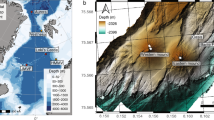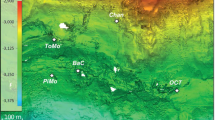Abstract
Recent discoveries on the northern Gulf of Mexico continental slope have altered our understanding of biological and chemical processes occurring in the deep ocean. A biological community of hydrothermal vent-type organisms was recently discovered at the base of the Florida Escarpment1, where the fauna are apparently nourished by hydrogen sulphide-rich hypersaline water seeping out onto the sea floor. Dense colonies of deep living chemosynthetic benthic organisms were first discovered during investigations of warm water anomalies along the axis of the Galapagos Rift in the Pacific Ocean in 19772—4, and this first discovery of clusters of clams, tube worms and other filter feeders in the immediate proximity of warm water vents has been followed by the discovery of a number of other hydrothermal vent sites, for example Guaymas Basin, East Pacific Rise at 21° N. The dense population assemblages at these sites are apparently restricted to small areas of the ocean floor where hydrogen sulphide-rich water is escaping from spreading centres, but the Florida Escarpment discovery indicates that these communities can also exist on passive margins. Here we report the discovery of dense biological communities associated with regions of oil and gas seepage on the Louisiana continental slope. These communities of large epi- and infaunal organisms are similar to those associated with the vents of the Pacific and the hypersaline brine seeps of the Florida Escarpment. Carbon isotope analyses suggest that these communities are chemosynthetic and derive their energy from hydrogen sulphide and/or hydrocarbons. Similar communities may be widely distributed on the sea floor in other oil-producing regions of the ocean.
This is a preview of subscription content, access via your institution
Access options
Subscribe to this journal
Receive 51 print issues and online access
$199.00 per year
only $3.90 per issue
Buy this article
- Purchase on Springer Link
- Instant access to full article PDF
Prices may be subject to local taxes which are calculated during checkout
Similar content being viewed by others
References
Paull, C. K. et al. Science 226, 965–967 (1984).
Ballard, R. D. Oceanus 20, 35–44 (1977).
Corliss, J. B. & Ballard, R. D. Natn. Geogr. 152, 441–453 (1977).
Lonsdale, P. Deep-Sea Res. 24, 857–863 (1977).
Brooks, J. M., Kennicutt, II, M. C., Fay, R. R., McDonald, T. J. & Sassen, R. Science 225, 409–411 (1984).
Anderson, R. K., Scalan, R. S., Parker, P. L. & Behrens, E. W. Science 222, 619–621 (1983).
Parker, P. L. Geochim. cosmochim. Acta 28, 1155–1164 (1964).
Williams, P. M. & Gordon, L. I. Deep-Sea Res. 17, 19–27 (1970).
Degens, E. T., Behrendt, M., Gotthardt, B., Reppmann, E. Deep-Sea Res. 15, 11–20 (1968).
DeNiro, M. J. & Epsteain, S. Geochim. cosmochim. Acta 42, 495–506 (1978).
Gearing, J. N., Gearing, P. J., Rudnick, D. T., Requejo, A. G. & Hutchins, M. J. Geochim. cosmochim. Acta 48, 1089–1098 (1984).
Rau, G. H. Science 213, 338–340 (1981).
Rau, G. H. & Hedges, J. I. Science 203, 648–649 (1979).
Williams, P. M., Smith, K. L., Druffel, E. M. & Linick, T. W. Nature 292, 448–449 (1981).
Karl, D. M., Wirsen, C. O. & Jannasch, H. W. Science 207, 1345–1347 (1980).
Cavanaugh, C. M. Nature 302, 58–61 (1983).
Felbeck, H. Science 213, 336–338 (1981).
Jannasch, H. W. Oceanus 27, 73–78 (1984).
Felbeck, H., Childress, J. J. & Somero, G. N. Nature 293, 291–293 (1981).
Author information
Authors and Affiliations
Rights and permissions
About this article
Cite this article
Kennicutt, M., Brooks, J., Bidigare, R. et al. Vent-type taxa in a hydrocarbon seep region on the Louisiana slope. Nature 317, 351–353 (1985). https://doi.org/10.1038/317351a0
Received:
Accepted:
Issue Date:
DOI: https://doi.org/10.1038/317351a0
This article is cited by
-
Identification and characterization of endosymbiosis-related immune genes in deep-sea mussels Gigantidas platifrons
Journal of Oceanology and Limnology (2020)
-
Gametogenesis and reproductive traits of the cold-seep mussel Gigantidas platifrons in the South China Sea
Journal of Oceanology and Limnology (2020)
-
Marine cold seeps and their manifestations: geological control, biogeochemical criteria and environmental conditions
International Journal of Earth Sciences (2014)
Comments
By submitting a comment you agree to abide by our Terms and Community Guidelines. If you find something abusive or that does not comply with our terms or guidelines please flag it as inappropriate.



